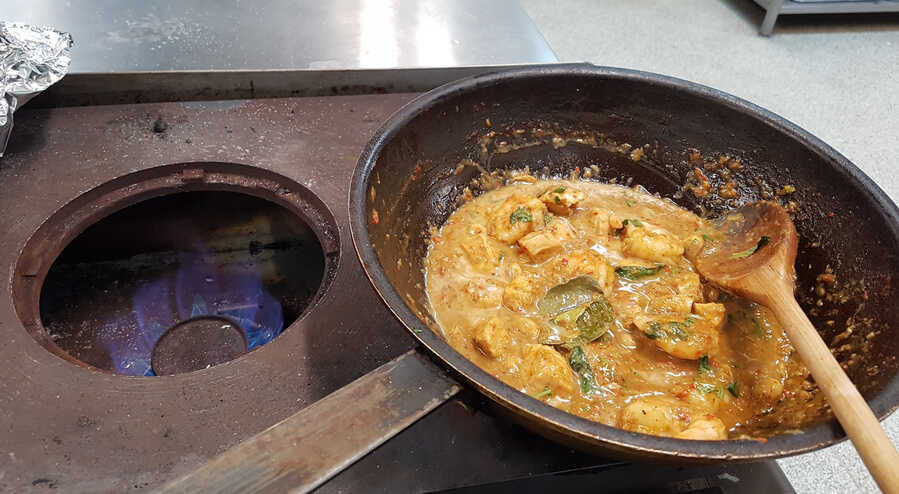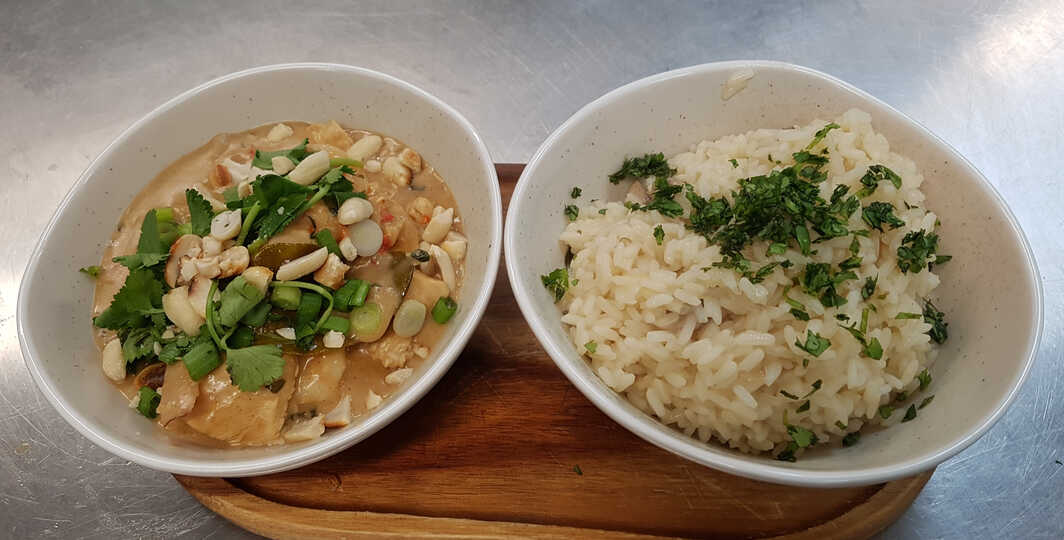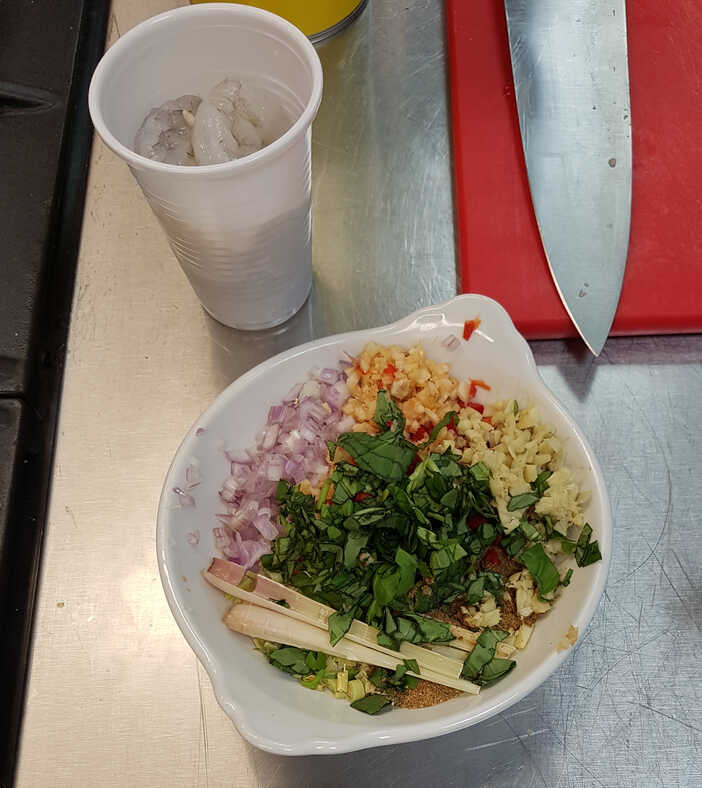Culinary Masterclass 3 - Thai One On
One of the quintessential Thai flavours is lemongrass, which fortunately was provided for our Thai dinner.
Freshly picked stalks may be several feet long, and the bright green leafy ends are much too fibrous to eat and need to be removed. There may also be dry, brittle outer leaves which also need to be stripped away leaving the softer pliable edible section a few inches long close to the root.
When you buy lemongrass in supermarkets this pre-prepared section is what you will get. Most of this is now edible though check that what you're using is fairly pliable, except for the very root end which has an extremely hard core that extends up the centre of the stalk. You can either cut all of this off - roughly from the root to the fattest part of the stalk, or slice your way down to it from the stalk end, stopping when you feel resistance to the knife.
Or you can bash the stem with a rolling pin and try to extract the hard root cone.
Lemongrass can be used just for its flavouring like a bay leaf — give the whole stalk a good beating with a rolling pin or a pestle to release the flavour and oils and throw it into a stew or a soup. Fish it out at the end when it's job is done.
Alternatively slice the stalk into thin rounds for pounding into paste, or again bash the stalk and mince it finely. Ideal for using in a stir-fry!
Beautifully fragrant Kaffir lime leaves can also be used whole to flavour a soup or stew like the Thai version of a bayleaf, but they're also fantastic shredded into a fine chiffonade and added at the end as a garnish.
We did get some lime leaves, but just the dried kind which can only be used as a bouquet garni. Though it can be hard to find fresh lime leaves, most chinese supermarkets will sell frozen ones, which are almost as good.
Galangal, another characteristic Thai ingredient, was also unavailable. It's a rhizome closely related to ginger, which you can substitute if you can't find any galangal.
Like ginger - use a spoon to lightly scrape away the skin before using, since much flavour is just under the surface which you will lose if you use a vegetable peeler.
Lee-tips:
Freshly picked stalks may be several feet long, and the bright green leafy ends are much too fibrous to eat and need to be removed. There may also be dry, brittle outer leaves which also need to be stripped away leaving the softer pliable edible section a few inches long close to the root.
When you buy lemongrass in supermarkets this pre-prepared section is what you will get. Most of this is now edible though check that what you're using is fairly pliable, except for the very root end which has an extremely hard core that extends up the centre of the stalk. You can either cut all of this off - roughly from the root to the fattest part of the stalk, or slice your way down to it from the stalk end, stopping when you feel resistance to the knife.
Or you can bash the stem with a rolling pin and try to extract the hard root cone.
Lemongrass can be used just for its flavouring like a bay leaf — give the whole stalk a good beating with a rolling pin or a pestle to release the flavour and oils and throw it into a stew or a soup. Fish it out at the end when it's job is done.
Alternatively slice the stalk into thin rounds for pounding into paste, or again bash the stalk and mince it finely. Ideal for using in a stir-fry!
Beautifully fragrant Kaffir lime leaves can also be used whole to flavour a soup or stew like the Thai version of a bayleaf, but they're also fantastic shredded into a fine chiffonade and added at the end as a garnish.
We did get some lime leaves, but just the dried kind which can only be used as a bouquet garni. Though it can be hard to find fresh lime leaves, most chinese supermarkets will sell frozen ones, which are almost as good.
Galangal, another characteristic Thai ingredient, was also unavailable. It's a rhizome closely related to ginger, which you can substitute if you can't find any galangal.
Like ginger - use a spoon to lightly scrape away the skin before using, since much flavour is just under the surface which you will lose if you use a vegetable peeler.
Lee-tips:
- Don't wash your fresh, delicate herbs under the tap - even such slight water pressure will damage them. Just swirl them in a bowl of water.
- After washing herbs, use them immediately - they won't keep now.
menu
It's a Thai!
Thai-style Curry
Thai-style Curry
Or panang-style. Made with chicken, or prawns, or both.
Mushroom Rice
A rice with a bit of body.
Thai-Style Panang Chicken and Prawn Curry
thai fowl fish main curry
Almost all Thai curry pastes will contain the base ingredients of garlic, shallots, fermented shrimp pastes and, of course, chillies.
These are pounded together in a pestle and mortar to make a smooth paste, together with the specific other additions which give each paste its particular character, such as lemon grass, galangal, coriander roots, makrut lime zest, or white peppercorns.
A red curry paste version will use red chillies, and green paste green chillies, which gives them their characteristic colours.
Yellow curry paste doesn't, as you might think, use yellow chillies! Its colour comes from grinding in fresh turmeric root.
The paste we made is more typical of a panang style which adds in cumin seeds, coriander seeds and roasted peanuts.
I disagree with Lee about the addition of leafy herb to the mixture though - they aren't usually included in pastes because their delicate flavours and bright colours will be lost during the protracted cooking the paste receives.
We had no galangal so we substituted ginger, no Thai basil so we used regular British basil, no shrimp paste, and no ground white peppercorns. And I couldn't be bothered to try and crush whole white peppercorns because we also had no pestle and mortar - so we simply finely chopped all our ingredients.
Lee demonstrated frying the chicken first in toasted sesame oil, then adding and frying the paste, then covering everything with coconut milk to simmer for 20-30 minutes.
In my recipe below I take the more traditional approach - scooping off the coconut cream from the top of the tin of milk, first frying the paste in this, then adding the chicken and finally the remaining watery coconut milk.
You might have to cheat and add some oil to get things going.
These are pounded together in a pestle and mortar to make a smooth paste, together with the specific other additions which give each paste its particular character, such as lemon grass, galangal, coriander roots, makrut lime zest, or white peppercorns.
A red curry paste version will use red chillies, and green paste green chillies, which gives them their characteristic colours.
Yellow curry paste doesn't, as you might think, use yellow chillies! Its colour comes from grinding in fresh turmeric root.
The paste we made is more typical of a panang style which adds in cumin seeds, coriander seeds and roasted peanuts.
I disagree with Lee about the addition of leafy herb to the mixture though - they aren't usually included in pastes because their delicate flavours and bright colours will be lost during the protracted cooking the paste receives.
We had no galangal so we substituted ginger, no Thai basil so we used regular British basil, no shrimp paste, and no ground white peppercorns. And I couldn't be bothered to try and crush whole white peppercorns because we also had no pestle and mortar - so we simply finely chopped all our ingredients.
Lee demonstrated frying the chicken first in toasted sesame oil, then adding and frying the paste, then covering everything with coconut milk to simmer for 20-30 minutes.
In my recipe below I take the more traditional approach - scooping off the coconut cream from the top of the tin of milk, first frying the paste in this, then adding the chicken and finally the remaining watery coconut milk.
Make sure you don't shake the coconut milk can before opening!
Poorer quality tins of coconut milk, such as those available in catering school, will contain less actual coconut,
and more emulsifying agents which will prevent the cream from splitting and crackling the way it's supposed to when you try to fry in it.You might have to cheat and add some oil to get things going.
Serves 2
Ingredients
- 1 chicken breast, cut into 1" dice
- half a dozen king prawns, peeled, de-veined
- 1 tin coconut milk unshaken
- chicken stock
- splash of fish sauce
- palm sugar optional
- kaffir lime leaves
- lime juice
For the paste:- 2-3 garlic cloves, minced or mashed
- 2 thai shallots, minced
- 1" piece ginger or galangal if you can get it, minced
- 1 lemongrass stalk, minced
- 1-6 red chillies, de-seeded, minced
- 1 tsp cumin powder
- 1 tstp coriander powder
- 1 tsp fermented shrimp paste
- coriander root well, stalks anyway, minced
- 1 tblsp peanut butter optional
Optional Garnishes:- peanuts, roasted, crushed
- spring onion, sliced
- coriander, chopped or torn
- lime zest
- Thai basil
- shredded kaffir lime leaves
Finely mince the shallots, chillies, lemongrass, and chillies.
Mix with the ground spices and a teaspoon of shrimp paste if you can get it.
Add any of: some minced coriander root or stalks, since you hardly ever see coriander with their roots attached in this country, a tablespoon of peanut butter, a splash of fish sauce, a grating of lime zest if you like.
Combine it all into a rough paste.
Cut the chicken breast into 1" cubes. Peel the prawns (if needed), and run a knife around the prawn's back to pick out and discard the black intestine which runs just under the surface.
Roast the peanuts under a grill, in the oven, or in a dry frying pan until they turn golden. Wrap them in a tea towel, or cling film, or put them in a plastic bag, and bash them with a rolling pin to crush them up if using.
Thinly slice spring onions if using.
Scoop the cream from the top of the coconut milk and fry over medium heat in a wok until it crackles and begins to separate.
Stir to coat then add the rest of the coconut milk, and chicken stock if required, to almost cover the chicken.
Throw in a lime leaf or three.
Cautiously add fish sauce to give a sour flavour.
Sweeten with a little palm or regular sugar if the sauce needs it.
Simmer gently for 10 minutes until the chicken is cooked, adding more stock if necessary. The sauce should have a custard-like consistency and coat the back of a spoon.
Stir through the prawns and cook them through for just a minute or two until they turn red.
Add a squeeze of lime juice and adjust the seasonings.
Remove from the heat, mix in some coriander or Thai basil and garnish with the crushed peanuts, sliced spring onions, lime zest or shredded lime leaves as you like.
And some rice.
Adjust the quantity of chilli according to their heat and your tolerance.
Mince or crush the garlic cloves.Mix with the ground spices and a teaspoon of shrimp paste if you can get it.
Add any of: some minced coriander root or stalks, since you hardly ever see coriander with their roots attached in this country, a tablespoon of peanut butter, a splash of fish sauce, a grating of lime zest if you like.
Combine it all into a rough paste.
Cut the chicken breast into 1" cubes. Peel the prawns (if needed), and run a knife around the prawn's back to pick out and discard the black intestine which runs just under the surface.
Roast the peanuts under a grill, in the oven, or in a dry frying pan until they turn golden. Wrap them in a tea towel, or cling film, or put them in a plastic bag, and bash them with a rolling pin to crush them up if using.
Thinly slice spring onions if using.
Scoop the cream from the top of the coconut milk and fry over medium heat in a wok until it crackles and begins to separate.
Add a little oil if it doesn't.
Add the paste mixture and fry until it releases its flavour and the oil separates, then add the chicken pieces.Stir to coat then add the rest of the coconut milk, and chicken stock if required, to almost cover the chicken.
Throw in a lime leaf or three.
Cautiously add fish sauce to give a sour flavour.
Sweeten with a little palm or regular sugar if the sauce needs it.
Simmer gently for 10 minutes until the chicken is cooked, adding more stock if necessary. The sauce should have a custard-like consistency and coat the back of a spoon.
Stir through the prawns and cook them through for just a minute or two until they turn red.
Add a squeeze of lime juice and adjust the seasonings.
Remove from the heat, mix in some coriander or Thai basil and garnish with the crushed peanuts, sliced spring onions, lime zest or shredded lime leaves as you like.
And some rice.
Delicious.
You can add in any kind of vegetable after the chicken has cooked if you like - fine beans, baby corn, mangetout, button mushrooms, more chillies, for instane.
I recommend maximum chilli 🙂
You can add in any kind of vegetable after the chicken has cooked if you like - fine beans, baby corn, mangetout, button mushrooms, more chillies, for instane.
I recommend maximum chilli 🙂
Mushroom Rice
staple veg
Lee suggested using 2½ times the quantity of water or stock to that of rice. Though he wasn't entirely clear on whether he meant by weight or by volume.
The usual proportions for basmati rice are twice the volume of water to rice. So I went with that.
The usual proportions for basmati rice are twice the volume of water to rice. So I went with that.
Serves 2
Ingredients
- 1 cup long-grain rice
- 2 cups chicken stock
- mushrooms, sliced
- salt
Optional flavourings:- lemon grass
- lime leaves
Optional garnish:- coriander leaves, chopped
- spring onions, sliced
Bring the stock to the boil.
Add the rice, stir, return to the boil, stir again.
Season.
Cover and leave on the hob until all the excess water has bubbled away and small pits are left in the rice surface.
Let sit over very low heat for 20-30 mins until the rice is tender and fluffy.
Serve scattered with chopped coriander leaves or sliced spring onions, if you like.
Throw in any aromatics you fancy. Bruised lemongrass stalks or kaffir lime leaves are nice.
Wash and slice the mushrooms and add them to the pot.Add the rice, stir, return to the boil, stir again.
Season.
Cover and leave on the hob until all the excess water has bubbled away and small pits are left in the rice surface.
Let sit over very low heat for 20-30 mins until the rice is tender and fluffy.
Serve scattered with chopped coriander leaves or sliced spring onions, if you like.
And with Thai-style chicken and prawn curry!



